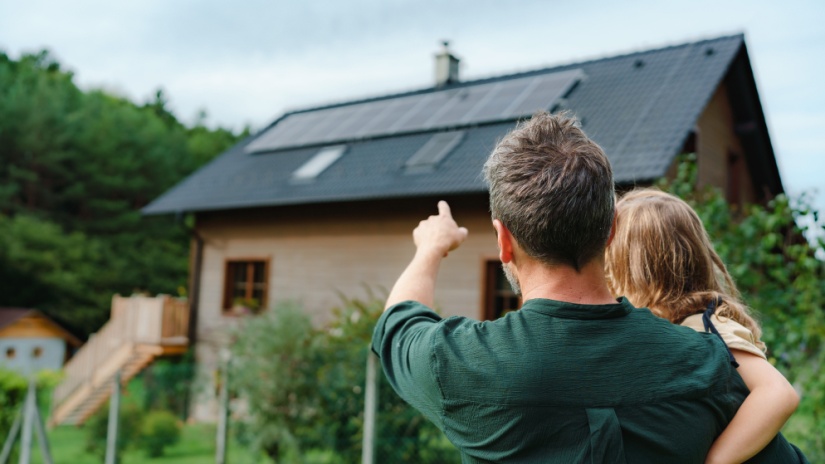Knowledge Centre
How do solar panels feed back into the grid?

When deciding to invest in solar energy, it's important to understand all aspects of the system, including back feeding. But what is back feeding, and how can it benefit you?
Back feeding occurs when your solar PV system generates more electricity than your household uses, and the excess energy is sent back to the electricity grid. This process is also known as exporting or feeding into the grid. In return, you receive a solar feed-in tariff (FiT), which can help offset your electricity costs.
To take advantage of back feeding, you need a grid-connected solar system. Even if you have a solar battery, any surplus energy beyond its storage capacity can be fed back into the grid. Understanding how solar panels feed back into the grid is the first step - let’s explore it now.
Grid connected energy
Connecting your solar panels to the local energy grid integrates you into a larger community power system. This setup allows you to both contribute to and draw from the collective energy pool.
Think of it like a neighbourhood book swap: you share the energy your panels generate, and in return, you can use electricity from the grid when needed.
Energy independence vs. off-grid vs. grid independence
When discussing energy independence, it's crucial to distinguish between being off-grid and grid independence. Off-grid means relying entirely on your own power sources, like solar panels, which can be ideal for remote areas but may have limitations. Understanding how solar panels feed excess energy back into the grid can address some of these challenges.
Grid independence, or grid-connected solar systems, strikes a balance. These systems pull solar power when it’s available, feed surplus energy back to the grid (earning credits on your bill), and draw power from the grid when solar production is low, such as during cloudy weather or at night.
This approach ensures a consistent and reliable energy supply while promoting environmental sustainability.
How does back feeding actually work?
Most households with solar panels are connected to the main electricity grid. This setup allows them to draw electricity from the grid when their solar energy production falls short of their household needs. Any surplus electricity generated by their solar system can be fed back into the grid, a process known as back feeding. Homeowners are compensated for this excess energy with a feed-in tariff (FiT).
Back feeding is when your solar panels produce more electricity than your home uses. Instead of wasting this excess energy, it's sent back to the main grid, contributing to the overall power supply. In return, homeowners receive a feed-in tariff, which helps offset their electricity bills. This process not only maximises the efficiency of the solar system but also supports the community's energy needs.
It's important to note that in some regions, there may be restrictions on the size of the solar system you can install for back feeding. These limitations are set by energy distributors to maintain grid stability and ensure safety. Before installing a solar system, it's advisable to check with your energy distributor to understand your options and any applicable regulations.
By connecting to the grid and leaning into back feeding, households can enjoy a reliable power supply, reduce their electricity costs, and contribute to a greener environment. This balance of drawing from and contributing to the grid allows for consistent energy availability and supports sustainable energy practices.
Will the grid buy back my excess energy?
If your solar system is connected to the grid, any extra solar power you generate can be sent back to the grid for a small credit on your bill.
Your electricity provider determines this payment, usually calculated in cents per kilowatt hour (c/kWh). Typically, these credits range from five to ten cents, though some providers offer higher feed-in tariffs (FiTs).
However, these higher FiTs are often part of specific solar electricity plans and may have certain conditions or eligibility requirements. Below, we've highlighted some of the current offers available.
Is there an alternative to feeding back into the grid?
Yes, there is. Instead of sending your excess solar electricity back to the grid, you can store it in a battery for later use, such as in the evening when solar production is low. With solar feed-in tariffs currently very low, many households find that using a battery to maximise solar power savings is a more attractive option.
If your solar system produces more electricity than your household uses, storing the extra energy can be more cost-effective. This stored energy can be used during times when grid electricity is more expensive, such as peak periods under a time-of-use tariff.
However, whether a solar battery is beneficial depends on your household’s energy usage patterns.
Connect with Compare Energy
Are you still on the fence about switching to a solar plan with our providers? Give our team a buzz on 1300 790 106 and we’ll happily talk you through the plans available and the benefits of harnessing the power of the sun to get your energy bills down.

